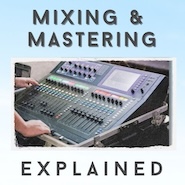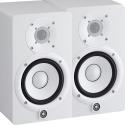
Mixing involves blending various audio elements, such as vocals, instruments, and effects, to create a cohesive sound. Once the mix is completed, the mastering process comes into play, where the mastering engineer uses various techniques to ensure that the mix sounds its best on all playback systems.
This includes adjusting the overall volume level, equalizing the frequency spectrum, and adding compression to control dynamic range.
Mastering also involves adding fades, spacing, and track sequencing to create a polished final product.
Mastering aims to create a consistent and balanced sound across all playback mediums, including streaming platforms, CD, vinyl, and radio broadcasts. This guide provides:
-
an in-depth understanding of how to master music and the mastering process,
-
its application in professional song production and
-
the technical distinctions between mixing and mastering.
What Is Audio Mastering?
Mastering is a crucial process that involves perfecting the entire mix by adjusting various sound elements. It encompasses tools and techniques such as equalization, saturation, and compression to achieve the desired results.
Mastering an entire track requires a deep understanding how various sound components interact. This includes adjusting stereo enhancement, frequency bands, and levels to ensure the mix sounds coherent and polished.
A professional mastering engineer has a keen ear for detail and listens out for any sound inconsistencies that could detract from the overall quality of the music.
In addition to fine-tuning, mastering involves improving the sound quality, making the track louder, and optimizing it for different speaker types.
The ultimate goal of mastering is to produce a clean, final mix that accurately represents the artistic vision of the music producer.
A Short History Of Mastering
The recording, mixing, and mastering processes were not distinct in the early days of music recording. The technology for recording sound started with the use of shellac-composite discs. However, the music recording process evolved with the introduction of the long play (LP) vinyl in the late 1940s.
Initially, sounds were recorded on tape, and the sound engineer would then use this magnetic tape recording to create a master disc. During this process, the sound engineer had to carefully adjust any excessively loud peaks in the recording to prevent disc-cutting or playing equipment damage. This was the first time sound professionals used mastering processes to enhance sound quality.
After that, sound artists continued to refine the stereo image of music through mixing and mastering, using various tools. As narrower discs with tighter grooves became available, equalization (EQ) became integral to mastering.
Over time, sound professionals moved away from cutting master discs and began to use mixing and mastering not only to ensure the safety of the disc and equipment but also to enhance the sound quality.
In the 1990s and 2000s, there was a transition from hardware mastering tools to mastering plug ins that could improve the sound quality of any track. This resulted in a flood of remastered tracks.
What Is The Difference Between Mixing And Mastering?
In the post-production stage, sound mixing and mastering are two distinct processes that require different skill sets. A mix engineer balances and adjusts individual tracks to create a cohesive mix during mixing. This involves adjusting the tonal balance and stereo imaging and adding compression, reverb, and other effects to enhance the overall sound quality.
On the other hand, mastering is the final step in the music production process, where a mastering engineer fine-tunes the stereo mix to ensure optimal playback on a wide range of sound systems. This final stage involves making precise adjustments to the overall EQ, dynamic range, and stereo width and adding subtle effects to enhance the mix.
Mastering aims to create a final, polished mix that accurately reflects the artist’s intentions and sounds great on any playback system.
How To Master Audio Like A Pro
Mastering audio involves many techniques skilled mix engineers apply to achieve the desired results. While the specific methods vary, the fundamental steps remain constant.
Step 1: Pre-Mastering Preparations
Preparation is everything, so ensure you have the mixes you want to master read in a lossless, full-resolution format. They should be at least 24-bit or 32-bit.
It is also a good idea to check that the mix is in stereo. Also, try to have the artist name, song or album name and the track listing available already.
This ensures that you can follow the tracks and shape a consistent musical flow for each song from start to finish.
As part of the mastering process, make sure that you have the right workstation, room, and speaker setup because this can have a big impact on the sound quality of your final mastered mix.
By taking care of these important factors, you can ensure that your final mastered mix means clarity, depth, and balance necessary to sound its very best on any sound system.
Step 2: Listen And Analyze
Before starting the mastering process, listening to the music is crucial to understanding the tracks. This step is a great starting point to get a comprehensive overview of the content and the adjustments needed. It is advisable to note down any issues you identify during this stage. Doing this can save you considerable time in the long run.
The next mastering stage involves analyzing each track in detail. Play the track several times, and list any excessive or insufficient elements you encounter. Listen to the track on various devices such as headphones, different speakers, and smartphones for an in-depth analysis.
Listen carefully for any unwanted noise, pops, or clicks left on your stereo mixdown. If necessary, cut them out to ensure the best possible sound quality.
You may need to send the mix back to the mixing engineer to address these problems. This approach provides a broad range of what stereo enhancement is required to make the song work for different outputs.
The detailed analysis provides an accurate picture of your song’s current sound and identifies the necessary adjustments to improve it. This technique lets you make all your mastering decisions intentionally, and you know precisely what part of the track requires what type of change.
Use A Wide Range Of References
To achieve optimal audio mastering, it’s imperative to have access to many comparable references to discern how the track will sound across different mediums, ranging from headphones and speakers to mobile devices.
Use A Graphic Analyzer
Apart from using your ears for audio mixing, graphic analyzers can also aid in comparing the frequency spectrum of multiple mixes.
The analyzer visually represents the frequency levels, highlighting areas with low or high frequencies.
The ideal frequency curve has no specific standard, varying for each song.
However, a graphic analyzer can help identify and fine-tune the less perceptible audio elements that are not easily noticeable to the human ear.
Use A Filter
To enhance the quality of the track, it is recommended to utilize a filter to eliminate the unwanted low frequencies.
A mid-side equalizer can filter the side channels exclusively, preserving the centered lower frequencies.
Step 3: The Mastering Session
After thoroughly analyzing your track, it’s time to dive into the hands-on creation of a consistent and polished sound.
To achieve this, digital signal processors (DSP) can be utilized for mix sound analysis and modification. DSPs such as compressors, equalizers, and limiters are commonly used to improve audio quality.
One of the easiest ways to work with these processes is through assistive audio technology, such as plugins. These plugins analyze the dynamic range and recommend mixing the sound according to your preferences.
Mastering engineers frequently use stereo enhancement plugins to improve audio tracks and create consistency across an entire album.
Several useful tools are available to create a coherent stereo image, including pan controls, stereo wideners, and mid-side processing. These tools can help create consistent sound distribution and enhance the stereo image, producing a polished and professional sound.
Expanders, Limiters And Compressors
Dynamic processing tools regulate the amplitude and dynamics of your mix for a refined and polished output. Play with the attack and release settings to find the right combination that works best with your audio. These are indispensable audio post production tools, which can be used for gain reduction, controlling loud transient peaks, and other polishing tasks.
Equalizer
An equalizer can be utilized to manipulate the amplitude of specific frequency bands in a track, for achieving frequency balance and altering the tonal quality of the music.
Harmonic Exciters
Harmonic exciters are audio processing tools that enable the addition of even or odd harmonics to a music mix. This creates a more dynamic and energetic sound. By manipulating the harmonic content of an audio signal, harmonic exciters can enhance the perceived loudness, clarity, and presence of individual tracks or an entire mix.
This technique can be particularly useful in mastering sound design applications where precise control over harmonic content is desired.
Limiters Or Maximizers
Audio engineers often use maximizers or limiters to prevent audio signal peaks from exceeding a certain threshold, which can cause clipping distortion.
These tools help to increase the overall levels of an audio file while maintaining the desired dynamic range and preventing distortion.
Stereo Imaging with Total Harmonic Distortion (THD)
Stereo imaging, with a particular focus on Total Harmonic Distortion (THD), is a psychoacoustic technique that enhances the perceived spatial localization of sound sources in a stereo output mix.
By manipulating the phase and amplitude relationships between the left and right audio channels, stereo imaging widens the perceived sound field, resulting in a more immersive and spacious listening experience.
Metering
Metering is an essential tool that allows you to analyze various aspects of your mastering adjustments visually. With metering, you can conveniently monitor your audio signals’ dynamic range, levels, and stereo widening.
Step 4: Feedback
Having completed the sound mastering process, the next step involves delivering the output to the artist or client for review.
It’s worth noting that most songs and albums usually undergo several feedback rounds before achieving the desired output quality.
Step 5: Preparations For Distribution
A thorough audio check is crucial, especially when preparing for different delivery formats. Each format demands specific modifications.
For instance, when converting sound into MP3 or AAC from WAV for online distribution, you may need to adjust the levels accordingly since some streaming services normalize audio or apply volume normalization during playback.
This meticulous process emphasizes “what is hi-fi,” catering to the nuances of various playback mediums. Additionally, understanding sample rate in audio becomes vital during the mastering process, as it influences the fidelity and resolution of the final master across different platforms.
Including metadata in your songs is equally essential.
Top Tips For A Professional Final Master
Mastering is a complex and nuanced art form requiring a keen ear and proficiency with the latest plugins.
Achieving a consistent level of quality control is crucial. Still, it is equally important to keep individual instruments separated and tailor the final output to specific mediums, such as streaming platforms or vinyl.
When working on a client’s master, it’s essential to understand their creative vision to produce a cohesive sound that accurately reflects their unique style. So spend time discussing these things with your client, especially if your offering online mastering services. This same principle applies to mastering your own music.
Here are some tips to remember to create an outstanding finished mix that meets the technical demands of streaming services, vinyl, and other output formats.
Don’t Mix And Master Together
To achieve a high-quality master, it is crucial to avoid mixing and mastering simultaneously, especially when you are the one mastering.
Mastering is a creative and technical process that demands time and expertise.
Taking a break of a day or two from your mixed track is recommended before commencing the finished master.
This pause is essential for your ears to rest and recover and for your mind to gain a fresh perspective on the project. This gives you fresh ears to better analyze your own master, including the different frequency bands, perceived volume levels, and all the elements that make a recording sound good.
Mind The Signal Chain
In mastering, the signal chain pertains to the sequential processing of effects applied to a track. These effects are interconnected and collectively impact the overall sound quality.
It is crucial to comprehensively understand how each adjustment and development operates relative to the others to achieve optimal results.
Match Volumes
When monitoring and analyzing your audio material, it’s crucial to level-match the volume of your reference tracks with the same volume level of your mix.
Failing to do so can lead to an inaccurate perception of your mix’s spectral balance and reveal artifacts or discrepancies that don’t exist.
If your reference track is too low or too high in volume, you may encounter difficulties achieving a cohesive master.
Create An Optimized Workspace
To achieve good sound quality in music, it is imperative to have an optimized listening environment during the mastering process.
This necessitates the use of acoustic panels in the room and a diverse array of speakers and headphones that can reveal the original imperfections in the track.
This enables the listener to identify what requires adjustment and appreciate the improvements made.
Keep Mastering Simple
Mastering is the final and most crucial stage in the production of a mix. To achieve a great master with polished and professional sound, keep the process simple by utilizing three essential tools: EQ, compressor, and limiter.
Address frequency imbalances with EQ, compress the mix and level everything out. This will ensure a consistent volume and a balanced sound across different playback systems.
Avoid Any Clipping
When exporting a mix, it’s common for the meters to clip some of the audio if the headroom is not managed correctly.
To avoid this, leaving approximately 6 decibels of headroom on the meters is recommended, which will help ensure that the mix won’t be clipped. This is especially important for rock and hip hop tracks with emphasized low-end.
Master For Each Delivery Format
In the past, vinyl record discs or shellac discs were the only output formats available, now there are numerous formats to consider, each with unique characteristics.
To ensure optimal sound quality, various adjustments must be made to accommodate the specific requirements of each format, including digital WAV format and other streaming formats.
Final Thoughts
A crucial step in preparing a song for release is mastering music. Mastering is indispensable in this era of diverse playback systems and distribution formats, including vinyl records, MP3s, and various streaming services.
And with today’s demand for professional songs that sound good, mastering has become more vital than ever before. It guarantees that listeners will have an outstanding listening experience with high-quality sound, regardless of the media format.
Therefore, mastering plays a critical role in ensuring that the music is presented to the audience in the best possible manner.
Contributors:
- Jerry Borillo – Illustrator






